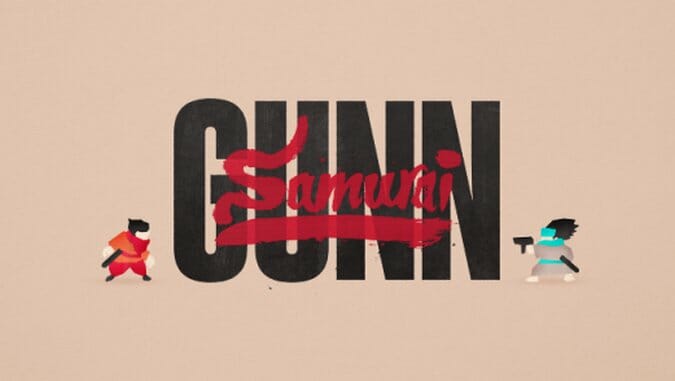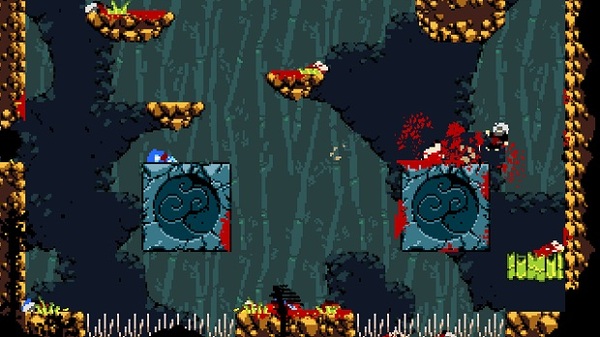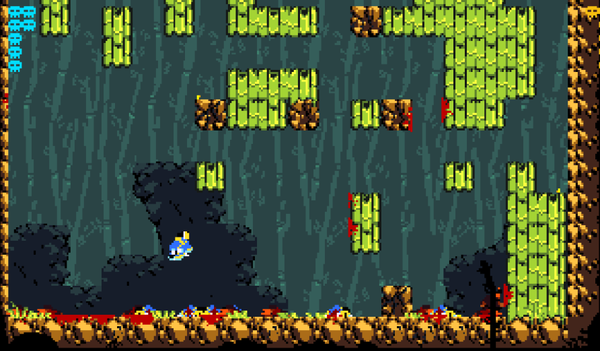
Samurai Gunn is a game you can play with three friends. If you own a Windows personal computer, you can buy this game for the price of one or five alcoholic beverages, depending on your preferred quality of alcohol. If you spend fifteen dollars on this game, and if you like people enough to spend twelve continuous hours with them, you will pay a dollar and a quarter per hour to make that time disappear. You might say you don’t own enough videogame controllers to play the game comfortably: To that, I say that some cheap controllers are not so bad (Xbox 360 wired controllers by the brand Rock Candy work just fine), and that you can play Samurai Gunn using just one computer keyboard (this latter method works best if you’re hanging out with three people whose skin you don’t mind touching on accident (or on purpose)).
Samurai Gunn is a member of the recent local-multiplayer competitive games movement. Some are quick to call this movement a “revival”, as though the makers of the games in question leafed through some picture books about old game arcades and decided a “throwback” was in order. I’d like to be more optimistic: Each of these recent competitive local multiplayer games is excellent in its own way with a sort of individual distinction that fills me with the faith that the creators arrived at their creations out of the sheer optimism for the concept of people enjoying competing at a simple thing.
Samurai Gunn is in fact simple: You use an analog stick or a directional pad or some computer keys to move your character. You press a button to swing your sword; you press a different button to jump; you press a third button to fire a bullet. You’re one of four players. You have to kill the other players. You have to kill them because they are all trying to kill you. Everyone is trying to kill everyone—or anyone—else. You kill other players by hitting them with your sword or shooting them with a bullet.
Your sword swings in a sublime trajectory and with a nuanced range and speed. You want to hit your opponent with your sword before your opponent’s sword can hit you. If you swing your swords at the same time, and they happen to collide, one of the game’s most perfect packaged “ooh” moments occurs: The two players slide backward with the force and vigor of their mutual attempted murder.
Bullets, meanwhile, fly in the direction the character was facing, and span the entire length of the screen.
This is important: You only get three bullets per life. Try to fire a bullet after firing all three, and you’ll hear an ineffectual click and see a limp puff of smoke.
One of the worst suggestions my friends made about Samurai Gunn is that the game has no on-screen indication of how many bullets you have remaining. This is a terrible suggestion, because you start each round knowing that you only have three bullets. Each bullet you fire is an event in itself. Samurai Gunn is asking you, with politeness, to be mindful of the number of big events you instigate.
Each time you kill an opponent, your score increases by one point. The game ends when one player has ten kills. At the end of the game, you see a detailed breakdown of every player’s kills versus deaths. In the event of a tie, the players have a “showdown” in front of a setting sun. The first player to slash the other player wins. These showdowns can be terribly tense.
How points are awarded at the end of a match—how kills, deaths and suicides are tallied, exactly—isn’t immediately clear to what I would call the vast majority of players. Yet this does not diminish a player’s enjoyment one bit. Samurai Gunn is a simple game, and at the minimal level it occupies a tiny, conversational space in the brain. Everyone I play it with is happy to be playing it. They don’t mind if they’re losing every game. They don’t mind which of the many arenas we choose to play in. They don’t get mad or passive-aggressive with one another. Even when we’re playing a round of every player to him or herself, players freely discuss tactics with one another. Because all of the arenas are so small (one screen) and because players move so quickly, the game becomes more about being in the right place at the right time than anything else. Because the visuals are juicy and the presentation is slick, people unacquainted with games will gladly sit through a dozen rounds before magical things happen and they’re suddenly thinking like shogun assassins and sharing tips, like, “Hey, you can slash downward while you’re falling”. What starts as a cluster of frantic kills and real-world guffaws will on a moment’s notice snap-freeze into dead silence and stillness. Then, one of the players tells two of the other players that we need to kill That God Darn Blue Guy Because He Is Better Than Us. Samurai Gunn is a social activity from the start, and it soon becomes a speed-decision-making contest of quite frankly miraculous elegance. Introducing a room of non-game-playing friends to the game, noticing that one of them excels beyond the others, and then watching the proceedings ebb over to the formerly beginner’s lucky friend’s eventual consistent second-placing feels like scientific proof that Samurai Gunn, in addition to being a Fun Little Thing, is also A Real Videogame Of The Highest Order.
Winning at Samurai Gunn feels good; losing at Samurai Gunn feels good. It feels good to win on any of Samurai Gunn’s various arenas; it feels good to lose on any of Samurai Gunn’s various arenas. Playing Samurai Gunn is like throwing a ball of paper at a wastebasket: Its kinetics are delightful, and winning and losing are equally addicting.
The kinetics are so delightful I owe them an exclusive paragraph: It is rare that I love the way objects move quite so much as I love the movement of objects in Samurai Gunn. Jumps have a gear-shifty piston motion on the upstroke which, while quirky, communicates instant intuition even to the first time player. The dramatic “shing” of the sword blade sweeps with just the right swiftness and arc. The friction of your character clinging to a wall is a sublime virtual facsimile of a thrown dart plicking into Styrofoam. The wiggly and juicy splatters of death-blood pixels and the clacking of cut bamboo pepper the game’s salad.
I couldn’t sleep at night if I weren’t negative about at least one thing in the course of a regular day, so I have to say that Samurai Gunn can be visually noisy. Take this criticism with a grain of salt: I consider the simple, plain, white, “Super Normal” MUJI coffee cup the pinnacle of modern design. As just this person (and also, um, as a person with a mildly lazy eye), I find Samurai Gunn’s colors and chunky pixels sometimes too exuberant. It hurts my head and my eyes sometimes to pick the characters and their movements out from among the ocean of colors and splatters. Yet I have heard a majority of the delighted players I’ve forced to play this game rave about the visuals: They just can’t get enough of it. Some of these people, in fact, have no sentimentality for “vintage” games, or “retro” game “pixel art”. The game looks curious and interesting even in a vacuum.
One thing I truly must criticize, however, is the camera movement. All of Samurai Gunn’s stages are exactly one screen in size. This way, the game design guarantees that all four of the players are visible at all times on the screen. However, some of the game’s stages have a semi-intelligent “camera” movement effect, meaning that the viewpoint slides around on a not-entirely-possible-to-predict schedule, sometimes filling parts of the screen with blackness, sometimes edging players’ characters off of the screen.
Many players I’ve talked to shrug this effect off, saying that it’s part of the “chaotic atmosphere” which “makes the game so great”. Some say that it communicates the thrill of the irrational or paranoid mindset of a warrior battle. I can understand these arguments, even if I don’t agree with them. In a game this fast-paced, where characters die and respawn mere blinks apart, the background should be the foundational pillow our eyes rest upon.
Some players also criticize the death effects: When a player dies—well, this also means that another player has killed that player, so this is a punishment to one player as much as it’s a reward to the other player, as much as it’s a boast between those two players: Segments of the screen cut away to highlight the region of the kill. The action pauses for a long instant, and that instant is uncomfortable to some players. Those players will complain: They will especially complain if they are losing. I personally like the effect (even when I am losing), though I would honestly propose a white background to highlight the kill, while keeping all of the other on-screen action in view.
My final picky complaint is that I wouldn’t have minded some stages with a full-screen 16:9 aspect ratio. Of course, this is an easy complaint for me to let go of: Samurai Gunn, with its pixel art and old-fashioned sounds, is obviously aiming for a more “retro” sensibility.
Samurai Gunn is ultimately a small game, of such elegant design that most players won’t even notice how critically it is making them think about timing and space and position and movement. Its rounds are short and fierce, and ultimately don’t inspire the seething grudges of a party game such as Mario Party, with its meta-board-game wrapper and long-term goals. Long-term goals are, among other things, a way of making people miserable at a party. Little games like Samurai Gunn are the party games of a new generation, tiny and alive and addictive and technically supercompetent. They are as casual as they are deep. Here is a game that might have come out on the Nintendo Entertainment System in 1989, though if it had, a publisher would have forced the developers to shoehorn in the heartbreaking, gamebreaking work of an hours-long story mode full of robust artificial intelligence and bosses that would look good on the back of a fifty-dollar box. Samurai Gunn arrives instead in an era of digital distribution, of the mainstream stardom (“acceptance”, if you will) of games in general, and at the exact point in time when competitive games have at last incorporated decades of player experiences into meaningful game design innovation.
What I just did there was this: I used a lot of words to tell you that Samurai Gunn is great, and that if you have people over your house, it doesn’t matter if they’re into football or Japanese 1970s psychedelic rock music or motorcycles or painting their fingernails: If you give them a controller, there’s a pretty good chance they can figure out how to have fun with this game—and each other!—on their first try.
Samurai Gunn was designed by Teknopants and published by Maxistentialism. It is available for the PC.
Tim Rogers is the founder and director of Action Button Entertainment, the game development studio behind Videoball. You can follow him on Twitter @108

